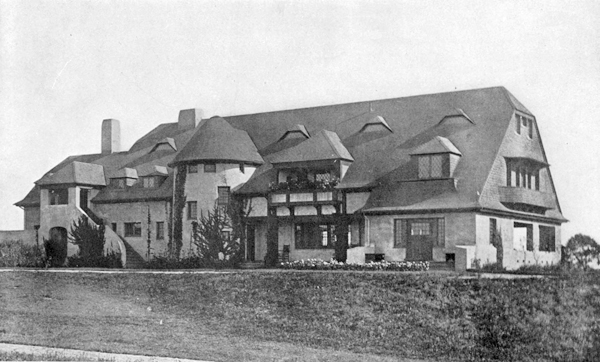
The East End might be thought of as a place of escape for many seasonal visitors, but it also often acted as a launching pad for the careers of many erstwhile architects, such as Grosvenor Atterbury.
Authors Peter Pennoyer and Anne Walker have brought a light to the overlooked talent of Mr. Atterbury in their new book, “The Architecture of Grosvenor Atterbury,” which the pair will discuss at the Parrish Art Museum in Southampton on Thursday, August 6, at 8 p.m.
There was a synchronicity to hosting the authors, Mark Segal, the public relations manager for the museum, said during a recent interview, noting that he and his colleagues have a special place in their hearts for the architect’s work, as the Parrish building was first imagined by Mr. Atterbury.
“We thought that it was great that we could host it in the building that he designed,” Mr. Segal said.
Mr. Atterbury, who died in 1956, is most known for his work on the model housing community of Forest Hills Gardens in Queens, but also designed several buildings, mostly palatial homes for wealthy industrialists, on the East End.
“He was very integral to the development of Southampton, Shinnecock Hills—and the Parrish Art Museum,” Ms. Walker explained during a telephone interview.
After studying at Yale University, Mr. Atterbury attended Columbia University to learn about architecture, and later travelled to Paris to study at the atelier of Paul Blondel. Upon his return to America, Mr. Atterbury worked in the offices of McKim, Mead & White, where he designed many country houses in Southampton and Shinnecock Hills during the first 10 years of his career.
The architect’s father, Charles Atterbury, was involved in founding the Shinnecock Hills Golf Club and the Shinnecock Summer School of Art. The younger Atterbury got a lot of his clients and patrons from his father’s acquaintances and friends, according to Mr. Pennoyer and Ms. Walker.
It was his designs of homes for wealthy clients that helped establish Mr. Atterbury as an architect, according to Mr. Pennoyer. “If you can build a beautiful and important house on the East End of Long Island, it’s a way of launching your career,” he said.
The architect built many significant structures in the area in addition to the Parrish Art Museum, including the Arthur Brigham Claflin house in Southampton; the Alfred H. Swayne house in Shinnecock Hills; the Albert and Adele Herter house, “Près Choisis,” in East Hampton; the Southampton Club; and many others.
Ms. Walker described the houses designed by Mr. Atterbury as “very naturalistic cottages that blended with the landscape.” Though some of the buildings have been demolished over time, many still stand today.
“Aside from architecture, he was part of that world or society who developed the East End,” Ms. Walker said.
“The Architecture of Grosvenor Atterbury” is the third book the pair has penned together. Each book has explored talented architects that might have otherwise been forgotten, the authors said.
“Ann and I are very interested in 20th century American architecture that became out of fashion when modernism became popular,” Mr. Pennoyer said, explaining that because Mr. Atterbury’s houses are so traditional in appearance, he was a less attractive subject to modernist critics. “We focus on talents who have been overlooked,” Ms. Walker added.